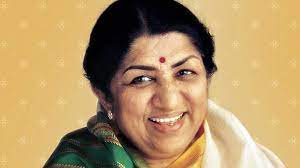Ehsan Fazili
“The gloomy shade of death”, in the words of William Shakespeare, has overshadowed India’s melody queen and its nightingale, whose mesmerising melodies buzzing in our ears continue to nurture our souls. The voice that echoes in every heart for nearly seven decades has silenced as Lata Mangeshkar bade adieu to this world. Those who have been listening to her melodies over the past several decades will continue to miss her, but the treasure that she has left behind, would continue to solace, as it has for generations.
As the legendary singer leaves this world, the most befitting tribute seems to be one of her own, heart rendering, popular songs of the later half of the last century, “Guzra Hua Zamana Aata Nahin Dobara, Hafiz Khuda Tumhara” from 1956 movie Shirin Farhad, as if chosen decades ago for this last moment. “Rahen na rahen hum, mehka karenge, ban kay kali banke saba bagh e wafa mein” equally suits the occasion. The treasure is so long that one can choose a song or many for each and every situation touching one’s life, romantic or tragic personified. It, however, becomes equally hard for one to choose a few from the plethora of beautiful songs in her mellifluous voice. Her sweet and captivating voice has been the hallmark of Hindi-Urdu music of Bollywood with its lovers across generations.
My memories take me back to the days when I was still a toddler, playing in the lap of parents and grand-parents in the mid 1960’s, when Bollywood music was in its heyday. Once tickling my father’s toes, I remember him murmuring one of Lata’s famed songs “Raja Ki Ayegi Baraat, Rangeeli Hogi Raat, Magan Main Nachungi…”, while feeling a sweet and faint smell of his cigarette smoking. That was loaded with love and affection for “Raja”, derived from my original name (Raja Ehsan ul Haq Fazili). Every time I happened to listen to this song later in my life, I would feel a sweet touch of that cigarette smoke, embedded in paternal love and affection.
Three decades–1950’s to 1970’s— saw a great number of Bollywood movies with the relentless hard work of people associated with its different fields. Lata Mangeshkar and Mohammad Rafi hold the first place in the list of singers of that era. “I have decorated the picture of Lata Mangeshkar in my home.When I enter the room I look at her photo and salute her”, comments Ab Wahid, a senior Physician, formerly with Sher-e-Kashmir Institute of Medical Sciences (SKIMS), Srinagar in one fb post. “Nobody could replace Mohd Rafi. No singer was as great as Rafi. I salute you on your birthday Rafi Sahib. And today I pray for a long life for the nightingale of the subcontinent Lata Mangeshkar. Nobody can replace her too”, he wrote in another post recently.
One of the huge treasure of Lata’s soul stirring songs, “Jab Pyar kiya toh darna kya………” from Mughal-e-Azam, is adorned by the melody queen with its opening couplet “Insaan kisi se Duniya mein ek baar Muhabbat karta hai, Iss Dard Ko laker jeeta hai Iss dard ko Lekar Marta hai”. There is again a plethora of heart-stirring songs that leave an impact matching any situation in one’s heart, especially its romantic side.
“Tera janaa, Dil k armanoon ka lut janaa”, one of the high pitch songs (Anari), has no match that touches the strings of one’s heart. Equally heart-touching are the compositions like “Na shikwa hai koi na koi gila hai…” and “Teray Sadqay balam….” (Amar, 1954) or “Ehsaan Tera Hoga Mujh Par Dil Jo Kehta hai….” from Junglee and “Aaj Phir Jeenay Ki Tamanna hai….” (Guide). Lata’s duets with a number of male singers are no less in their quality and impact. Only a few of them “Aaja Sanam Madhur Chandni mein hum tum milay to veerane mein bhi aa jayegi Bahar (Chori Chori), Pyar hua Ikrar hua hai pyar sey phir kyon darta hai dil (Shree 420) or “Dum Bhar Jo udhar munh phere……. (Awara), “Jo wada kiya woh nibhana padega…” (Taj Mahal), and “Yunhi tum mujsay baat karti ho, ya koi pyar ka irada hai….” (Sacha Jhoota).
As a playback singer, Lata’s voice was the most lip synced for the heroines or other women’s faces on the cinema screen for more than seven decades from the black and white to the colour films. The heroines of yesteryears like Madhubala and Nargis Dutt, in particular had a great affinity and love for this voice, as it matched their expressions, based on the story. Tears come down from the eyes by her voice, Nargis Dutt had once aptly said. Madhubala, the most celebrated actress during 1950-1960’s, had a column included in her contract that all the songs filmed on her be sung by Lata Mangeshkar only.
Undoubtedly, the singing icon ruled the hearts. Her voice was even part of the 1988 televised song “Mile Sur Mera Tumhara” promoting national integration and unity in diversity. The DD production in Assamese, Bengali, Gujarati, Hindi, Kannada, Kashmiri, Malayalam, Marathi, Odia, Punjabi, Sindhi, Tamil, Telugu and Urdu languages featured the respective locations. Towards the conclusion it featured Bollywood actresses, Hima Malini, Sharmila Tagore, Waheeda Rehman, Tanuja and Shabana Azmi, with Lata’s playback, like those in the movies, adding life to the presentation. As the short film concludes with her face singing “Mile Sur Mera Tumhara…..” the most popular voice echoes on.


